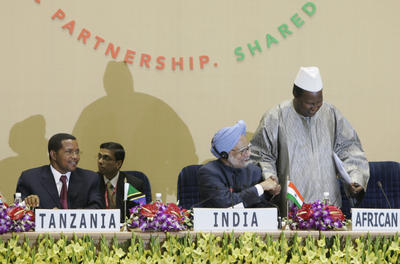Most assessments of this topic, with few exceptions, have relied on anecdotes and subjective judgments. Meaningful policy recommendations require systematic, objective analysis.
A critical starting point is to establish the proper context. What Chinese and Indian firms are doing in Africa is not unique or new. South-South commerce has been growing rapidly for over two decades. South-South trade doubled from about 8per cent of world trade in 1990 to over 16per cent in 2007. The share of developing countries’ exports going to developing countries increased from 29per cent in 1990 to 47per cent in 2008.
Rigorous analysis of systematically collected data reveals several weak spots in the conventional wisdom about Chinese and Indian firms’ activities in Africa. Most observers believe Chinese (and to a lesser extent Indian) firms dominate Africa’s economies. This presumption does not fit the facts. About 90per cent of the stock of FDI in Africa still originates from Northern companies, especially those from the European Union and the United States. The confusion arises because FDI inflows in recent years have been dominated by Chinese and Indian multinational enterprises (MNEs) (as well as other firms from the South).
Received wisdom also has it that the ‘new’ Southern investors in Africa are exclusively involved in natural resources. But Chinese and Indian MNEs in Africa are increasing their investments into other sectors, such as telecommunications, financial services, food processing, manufacturing, infrastructure, back-office services, and tourism. Although natural resource-based investments dominate Chinese and Indian investors’ portfolios in Africa in value, it is evident from the number of FDI projects that investment by these MNEs is beginning to diversify rapidly across many sectors.
Most press articles and the few recent books on this topic focus only on Chinese enterprises. But doing so raises serious methodological questions about the quality of these analyses’ policy conclusions and trend prognostications. Without including comparator or control countries, such as India, Brazil or others from the South increasing commerce with Africa, it is difficult to make meaningful assessments of the status quo, let alone of any counterfactuals.
New business case studies and firm-level survey data on the African operations of Chinese and Indian firms show that, due to inherent differences in ownership and other facets, Chinese and Indian firms generally perceive investment risks differently, and this colors their business strategies in Africa. The average Chinese firm operating on the continent is a large state-owned enterprise (like most Chinese MNEs operating globally) and tends to enter new markets by building de novo facilities, is highly vertically integrated, rarely encourages the integration of its management and workers into the African socioeconomic fabric, conducts most of its sales in Africa with government entities, and (able to avail itself of its home government’s deep pockets,) exploits its ability to out-compete other bidders for government procurement contracts.
The typical Indian firm, tends to be in the private sector, varies in size, enters African markets by acquiring established businesses, engages in vertical integration (but much less so than its Chinese counterpart), facilitates — indeed, sometimes encourages—the integration of management and workers into the African socioeconomic network (through informal ethnic networks or by participating in local political activities), and engages in large local sales with private entities rather than solely government agencies.
These new data also show that Chinese and Indian firms have much in common in their African operations. MNEs from both countries have begun to play a significant role in facilitating mutually reinforcing links between trade and FDI in Africa. One consequence of their presence is that inward FDI is engendering an increase in Africa’s exports.
Chinese and Indian businesses, by dint of their generic organizational structures, can achieve larger operations in Africa — and thus greater economies of scale and higher productivity — than their African counterparts. They can thus export goods from Africa that are more diversified and higher up the value chain than can African firms in the same sectors. They are also integrating horizontally more extensively across Africa’s own internal market — a critical objective for a continent comprising many landlocked countries with individual markets far below commercial scale. Chinese and Indian MNEs, increasingly in joint ventures with African firms, are fostering exports from Africa to a wider set of markets outside the continent.
Much is at stake for the 800 million people in sub-Saharan Africa, especially the 50per cent of them who are among the world’s poorest, in the policy debate concerning the continent’s accelerated integration into the world economy through South-South commerce, now led by China and India. The quality of this debate needs to be improved. It could start by: development of systematic empirically -derived, cross-country and cross-sectorally consistent data; application of a rigorous analytical methodology; and use of an objective, coherent framework from which one can draw dispassionate policy conclusions for all concerned — Africans (businesses, workers, consumers, policy makers), foreign investors and their home country constituencies, and the international community.
Harry G. Broadman is Senior Vice President of Albright Stonebridge Group LLC, a global consultancy, and Chief Economist of Albright Capital Management LLC, an emerging markets investment management firm. This piece was first published here, on 17 February 2011, as Columbia FDI Perspectives Paper No. 34, by the Vale Columbia Center on Sustainable International Investment.

